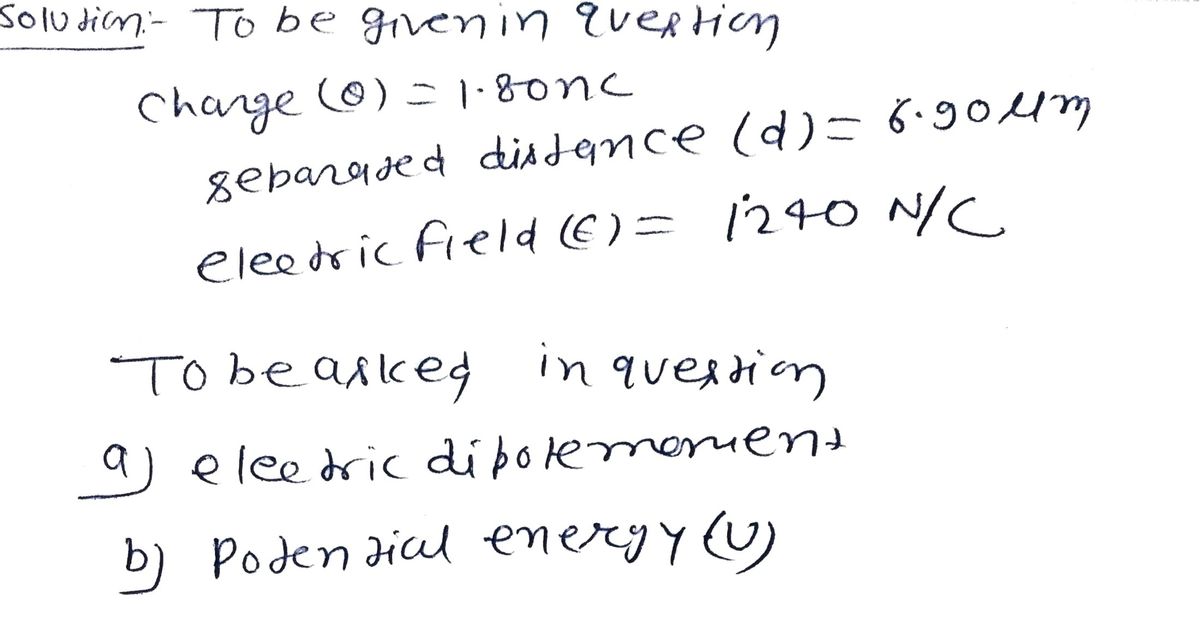
College Physics
11th Edition
ISBN: 9781305952300
Author: Raymond A. Serway, Chris Vuille
Publisher: Cengage Learning
expand_more
expand_more
format_list_bulleted
Concept explainers
Question

Transcribed Image Text:An electric dipole consisting of charges of magnitude 1.80 nC separated by 6.90 µm is in an electric field of strength 1240 N/C. What
are (a) the magnitude of the electric dipole moment and (b) the difference between the potential energies for dipole orientations
parallel and antiparallel to
?
Units
(a) Number
Units
(b) Number
Expert Solution
arrow_forward
Step 1

Step by stepSolved in 3 steps with 4 images

Knowledge Booster
Learn more about
Need a deep-dive on the concept behind this application? Look no further. Learn more about this topic, physics and related others by exploring similar questions and additional content below.Similar questions
- A capacitor is composed of two metal plates. The two plates have the dimensions L = 0.11 m and W = 0.56 m. The plates have a distance between them of d = 0.1 m, and are parallel to each other. Part (a) The plates are connected to a battery and charged such that the first plate has a charge of q. Write an expression for the magnitude of the electric field, |E|, halfway between the plates. Part (b) Input an expression for the magnitude of the electric field, |E2|, just in front of plate two. Part (c) If plate two has a total charge of q = -1 mC, what is its charge density, σ, in C/m2?arrow_forwardTwo large (treat as infinite) parallel conducting plates are charged to t Q as shown by the battery. A proton is released from rest at point A and is measured to be moving with a speed v, = 2 x 105 m/s when at point B. The right plate is then moved closer to the left as shown in the %3D X X rightmost figure. The experiment is repeated. What will be the speed of the proton at point B? A) Greater B) Smaller C) Equal D) Impossible to determinearrow_forwardTwo large parallel plates carry opposite charges of equal magnitude. They are separated by 80.0 mm and the potential difference is 120 V. What is a magnitude of the uniform electric field in the region between the plates?arrow_forward
- Show transcribed image text An electric field is given by Ex = 3.5x^3 kN/C. Find the potential difference between the points on the x axis at x = 1 m and x = 4 m. kV Find the maximum surface charge density sigma max that can exist on the surface of any conductor before dielectric breakdown of a gas with a dielectric strength of 3.95 MV/m occurs. C/m^2arrow_forwardTwo electric dipoles of dipole moment p, and p, are placed at origin such that one is along x-axis and the P2 3 òther along y-axis respectively. If potential at point (r,0) is zero then P2 is (а) 1 (b) cot0 (c) tan 0 (d) sin0.cos0arrow_forwardA parallel plate capacitor consists of two rectangular, horizontally oriented plates, each with an area of 4.00 cm2, and separated by a distance of 0.300 mm. If the magnitude of the charge on each capacitor is 5.00 nC, what is the magnitude of the electric field between both plates?arrow_forward
- Two charges are placed between the plates of a parallel plate capacitor. One charge is +q₁ and the other is q2 = +4.30 μC. The charge per unit area on each plate has a magnitude of a -7.78 x 10 C/m². The force on q; due to q2 equals the force on as due to the electric field of the parallel plate capacitor. What is the distance r between the two charges? Number 1 Units marrow_forwardA cars bumper is designed to withstand a 4.0km/h (1.1 -m/s) collision with an immovable object without damaging the body of the car. The bumper cushions the shock by absorbing the force over a distance. Calculate the magnitude of the average force on a bumper that collapses 0.185m while bringing a 875kg car to rest from an initial speed of 0.85m/s in newtons.arrow_forward
arrow_back_ios
arrow_forward_ios
Recommended textbooks for you
 College PhysicsPhysicsISBN:9781305952300Author:Raymond A. Serway, Chris VuillePublisher:Cengage Learning
College PhysicsPhysicsISBN:9781305952300Author:Raymond A. Serway, Chris VuillePublisher:Cengage Learning University Physics (14th Edition)PhysicsISBN:9780133969290Author:Hugh D. Young, Roger A. FreedmanPublisher:PEARSON
University Physics (14th Edition)PhysicsISBN:9780133969290Author:Hugh D. Young, Roger A. FreedmanPublisher:PEARSON Introduction To Quantum MechanicsPhysicsISBN:9781107189638Author:Griffiths, David J., Schroeter, Darrell F.Publisher:Cambridge University Press
Introduction To Quantum MechanicsPhysicsISBN:9781107189638Author:Griffiths, David J., Schroeter, Darrell F.Publisher:Cambridge University Press Physics for Scientists and EngineersPhysicsISBN:9781337553278Author:Raymond A. Serway, John W. JewettPublisher:Cengage Learning
Physics for Scientists and EngineersPhysicsISBN:9781337553278Author:Raymond A. Serway, John W. JewettPublisher:Cengage Learning Lecture- Tutorials for Introductory AstronomyPhysicsISBN:9780321820464Author:Edward E. Prather, Tim P. Slater, Jeff P. Adams, Gina BrissendenPublisher:Addison-Wesley
Lecture- Tutorials for Introductory AstronomyPhysicsISBN:9780321820464Author:Edward E. Prather, Tim P. Slater, Jeff P. Adams, Gina BrissendenPublisher:Addison-Wesley College Physics: A Strategic Approach (4th Editio...PhysicsISBN:9780134609034Author:Randall D. Knight (Professor Emeritus), Brian Jones, Stuart FieldPublisher:PEARSON
College Physics: A Strategic Approach (4th Editio...PhysicsISBN:9780134609034Author:Randall D. Knight (Professor Emeritus), Brian Jones, Stuart FieldPublisher:PEARSON

College Physics
Physics
ISBN:9781305952300
Author:Raymond A. Serway, Chris Vuille
Publisher:Cengage Learning

University Physics (14th Edition)
Physics
ISBN:9780133969290
Author:Hugh D. Young, Roger A. Freedman
Publisher:PEARSON

Introduction To Quantum Mechanics
Physics
ISBN:9781107189638
Author:Griffiths, David J., Schroeter, Darrell F.
Publisher:Cambridge University Press

Physics for Scientists and Engineers
Physics
ISBN:9781337553278
Author:Raymond A. Serway, John W. Jewett
Publisher:Cengage Learning

Lecture- Tutorials for Introductory Astronomy
Physics
ISBN:9780321820464
Author:Edward E. Prather, Tim P. Slater, Jeff P. Adams, Gina Brissenden
Publisher:Addison-Wesley

College Physics: A Strategic Approach (4th Editio...
Physics
ISBN:9780134609034
Author:Randall D. Knight (Professor Emeritus), Brian Jones, Stuart Field
Publisher:PEARSON